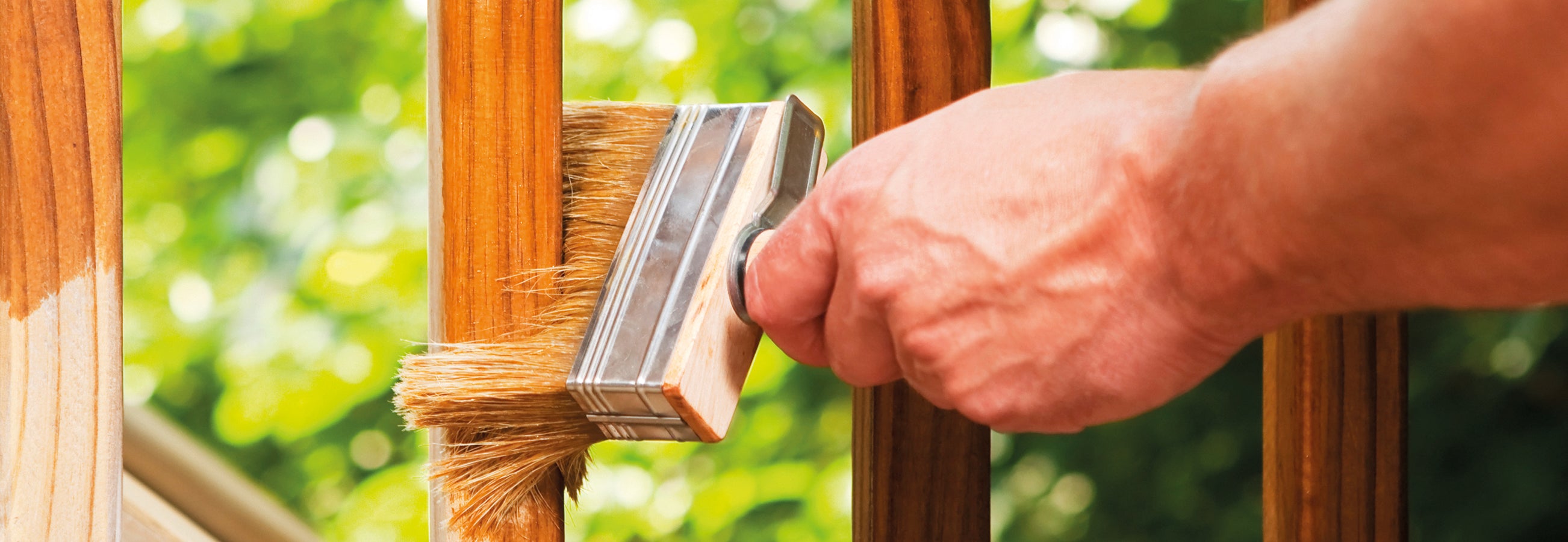Contents
Oiling Wood - Protection & Refinement
Contents
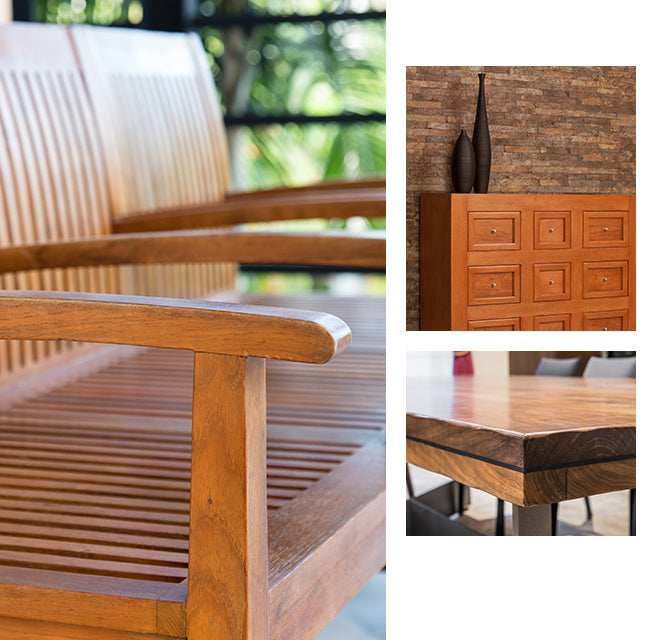
subheading
Oiling wood – how to treat wooden surfaces with oil
You can quickly and easily ensure that wood material is optimally protected and gives it a high-quality look. You don't need varnishes or glazes for this, just wood preservatives. With wood oil, you not only make the oiled material much more resistant, but also allow it to breathe so that any moisture it has absorbed can be released again, and skilfully showcase the natural grain. Anyone who decides to oil wood is quickly faced with many questions: How do you apply wood oil? How long does it take for the product to soak into wood and what does wood oil actually do? In this article, we'll tell you how to oil wooden furniture and garden furniture correctly and everything you need to know about wood products, oiling wood, etc., including instructions.
subheading
Oiling wood: How to do it
In this guide, we will show you step by step how to oil wood correctly and how to properly treat your wooden furniture with the product.
subheading
1. Materials and tools for oiling wood
To oil wood you will need sandpaper with a grain of 180-220 or abrasive fleece for sanding, several lint-free linen cloths or a cotton cloth, alternatively a brush for paint and the wood oil .
2. Preparation of the wood
First, thoroughly clean the base area of any dirt with a cloth and optionally a special cleaner. The surface should then be dry for sanding. Then start sanding the base area with the sandpaper in the direction of the grain. After treatment with sandpaper with the correct grain, there should be no bumps or scratches at the end. Then clean the surface again so that all sanding dust is removed and the wood is dry.
3. Apply the oil with a brush or cloth
Now it's time to oil the wood. Apply the oil with a lint-free cloth or a brush. Be generous. If the top looks damp, you have applied enough wood oil.
4. Allow the oil to dry
Now let the oil work for between 30 and 60 minutes, but do not let it dry completely.
subheading
5. Remove any oil that has not been absorbed
After waiting for the wood oil to dry, remove any excess oil with a clean, lint-free cloth.
6. Allow the oil to dry for several hours
Now allow the oiled surface or wooden floor to rest for several hours, even overnight.
7. Oil the wood several times until it looks as desired
After the longer rest period, check the condition. If the wood still feels rough after oiling or does not have the desired look, apply another layer of oil and follow the instructions as you did the first time, starting from the point after sanding. Don't forget to remove the excess liquid again. It can be worthwhile to sand the surface again with a fine grit.
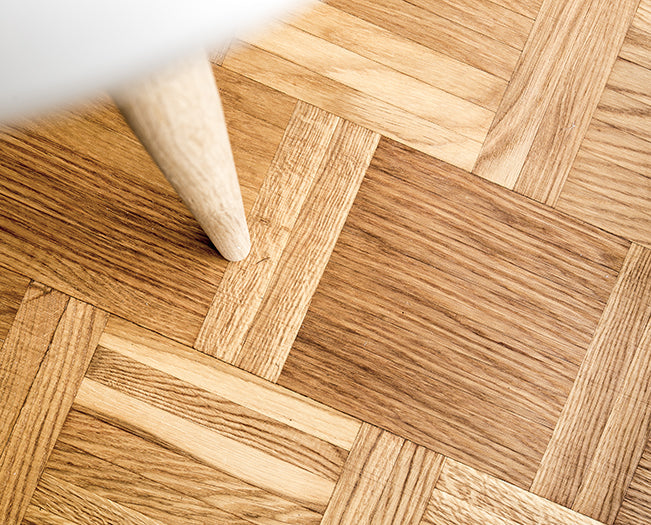
subheading
Knowledge about wood oil and wood oiling
It is important to know how to oil wood, but if you are thinking about working with your wood, there are other things you should consider. Below we will tell you which surfaces are suitable for oiling wood, what effect it has on wood fibers, what advantages and disadvantages the properties have, and which ones are particularly suitable.
Welche Oberflächen lassen sich behandeln?
Generell lassen sich alle nicht lackierten oder lasierten Holzoberflächen sowohl im Innen- als auch im Außenbereich mit Holzöl bearbeiten. Ob Parkettboden, Holzböden, Massivholz-Tisch oder Gartenmöbel, die Behandlung mit geeignetem Öl zeigt sich vielseitig anwendbar. Für den Außenbereich werden zum Holz ölen spezielle Öle verwendet, die sich witterungsresistent zeigen, hohen Beanspruchungen standhalten und starke Verschmutzungen verhindern.
Was bewirkt Holz ölen?
In erster Linie dient die Bearbeitung mit Öl dem Schutz des Materials. Öle dringend in die Poren der Oberfläche ein, lassen das Holz dennoch atmen. Das bewirkt wiederum, dass zwar Feuchtigkeit eindringen kann, diese aber auch wieder abgegeben wird. Damit wird verhindert, dass Feuchtigkeit im Inneren entsteht und das Holz morsch wird. Im Gegenteil, das Öl entfaltet seine pflegenden Eigenschaften im Inneren der Holzfasern. Es entsteht eine gute Luftfeuchtigkeit. Holzböden und Co. erstrahlen zudem schnell wieder im neuen Glanz, wirken wie frisch gewachst.
Diese Vorteile haben Holzöle
Mit den speziellen Ölen wird die Bildung von Rissen sowie das Austrocknen verhindert. Kratzer lassen sich einfach wegschleifen, auch auf Holzböden.
Die Optik einer mit Ölen behandelten Oberfläche oder eines Holzfußbodens macht einiges her. Die Maserung und der natürliche Farbton beispielweise kommen nun bei der Holzoberfläche besondere gut zur Geltung. Letztlich zeigen sich geölte Holzoberflächen angenehm in der Berührung, wie bei Armlehnen von Gartenmöbeln oder Holzböden. Die Öle lassen sich zudem leicht auftragen und tun den Holzfasern rundum gut.
Die Nachteile von Holzöl
Die Nachteile sind, dass Du beim Holz ölen keine porenschließende Holzoberfläche der Werkstücke schaffen und die Holzfasern nicht versiegeln kannst. Schmutz dringt also weiterhin ein. Daher ist es wichtig, dass Du regelmäßig das Holz ölen wirst. Wie oft, das hängt davon ab wie stark die Nutzung ist. Sobald sich die geölte Holzoberfläche wieder rau zeigt, ist es Zeit das Holz erneut zu ölen.
Holz ölen oder lackieren – was ist besser?
Mit einem Überzug aus Lack oder einer lackierten Lasur schaffst Du auf der Holzoberfläche eine geschlossene Schicht. Das verhindert, dass Schmutz eindringt und sorgt gleichzeitig dafür, dass das Material nicht atmen kann. Das ist wichtig, damit Feuchtigkeit wieder abgegeben und die Luftfeuchtigkeit reguliert werden kann. Zudem können Lacke gesundheitlich bedenklich sein, was bei den Ölen seltener der Fall ist. Für viele ist das natürliche Aussehen wichtig, was mit dem Ölen weiterhin gegeben ist. Daher lässt sich sagen, dass Holz ölen einen klaren Vorteil hat.
Welche Öle eignen sich zum Holz ölen?
Holzöle können sowohl für den Innenbereich als auch für den Außenbereich genutzt werden. Dabei gibt es unterschiedliche Varianten, die sich für Möbel in deiner Immobilie eignen oder besser zum Holz ölen von Garten- oder Terrassenmöbeln als Schutz im Außenbereich zum Einsatz kommen.
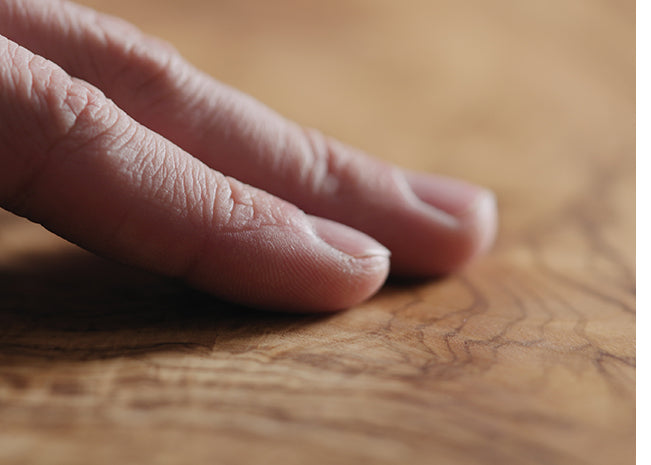
subheading
Which oils are suitable for oiling wood?
Hardware stores have the right product for oiling wood for almost every type of wood, but the supermarket can also be a good place to start. A distinction is made between natural oils such as linseed oil, walnut oil and tung oil and optimized variants known as hard oils that can be used for processing. The products do not contain any color that could penetrate the pores when oiling the wood.
Hard oils are linseed oil that is boiled in the absence of air and mixed with natural resin, among other things. This ensures that hard oils with the natural resin they contain have the property of forming a robust layer, making the material particularly resistant and producing a beautiful shine and a natural color. Hard oils are therefore mostly used for wooden floors that are subject to heavy wear and tear.
subheading
There are also teak oils that contain color pigments and are suitable for teak or similar workpieces. Teak oil is suitable for use on teak, for example if table tops are to be given a medium brown color. Special parquet oils for parquet complete the range. Worktops in the kitchen or wooden toys for children should always be treated with tested wood oil variants that are suitable for this purpose.
Hard wax oils are based on oil and wax. Hard wax oils with wax have a water-repellent effect on the surfaces and are more resistant to stains. A good hard wax oil is therefore also often used for oiling wood; it hardens well, protects the material and dries quickly. The floor is waxed at the same time.
Many DIY enthusiasts swear by siccative variants for oiling wood. These contain drying agents that allow for faster drying. However, some patience is required with the siccative products, even if the siccative agents require less time to dry in comparison.
subheading
linseed oil
Linseed oil is often the first choice of natural products and substances for oiling wood and has always been used to treat natural surfaces. The advantages of oiling wood with linseed oil compared to walnut oil and tung oil: It penetrates deep into the pores of the wood fibers, dries quickly and hardens well. If you want it to be even faster, then use siccative linseed oil, which is called linseed oil varnish because of the siccative drying agents. Linseed oil or linseed oil varnish is recommended, but also tung oil, especially for oiling wood indoors.
Baufix Wood Care Oil
You can find a particularly simple and reliable way to protect your wood with BAUFIX wood care oil. This is a high-quality special oil that has little odor and is ideal for hardwood garden furniture, wooden terraces and wooden walkways as well as wooden furniture indoors. The care oil is available in different colors that emphasize the natural color of the wood, while also having an impregnating effect when treating the wood and protecting it from dirt and stains.
If you have a surface or furniture that has already been treated with a substance, you must first completely sand off the layer with sandpaper before you can oil the wood.
What about sunflower oil or olive oil?
When treating wood professionally, you should never use cooking oils such as olive oil, sunflower oil or rapeseed oil. The reason: These cooking oils do not dry completely, unlike drying household oils such as linseed oil, tung oil and walnut oil. The fatality of using cooking oils such as olive oil or sunflower oil becomes apparent over time. In combination with oxygen, the cooking oils become rancid and can form mold. Furthermore, liquids such as olive oil and rapeseed oil can cause discoloration in addition to forming a rancid layer. Therefore, it is better to use linseed oil varnish to oil wood, which has a nourishing effect.
Holz ölen – einfacher als gedacht mit dem richtigen Öl und ein wenig Geduld
Es lässt sich festhalten, dass die Bearbeitung mit entsprechenden Ölen wie Hartölen für Fußböden, Leinölen, Walnussölen und Tungölen für Möbelstücke und Werkstücke im Innenbereich und speziellen Mitteln wie dem BAUFIX Holz-Pflegeöl für Innen und Außen wichtig ist. Heimwerker fördern die Beständigkeit des natürlichen Materials, vermeiden Verschmutzungen und erhalten die Optik bzw. unterstreichen diese. Zwar dauert die Trocknung etwas länger und es ist eine Auffrischung nötig, was bei einer Lasur oder dem Lackieren nicht der Fall wäre, doch die Vorteile zum Holz ölen überwiegen. Und so kann es gar Spaß machen einmal im Jahr seine Möbelstücke wie Tischplatten und Co. zu bearbeiten und auf Vordermann zu bringen. Die Belohnung ist in jedem Fall ein frisches Aussehen nach der Holzbehandlung mit Leinöl, Tungöl, Hartöl, Teaköl oder Baufix Pflegeöl.
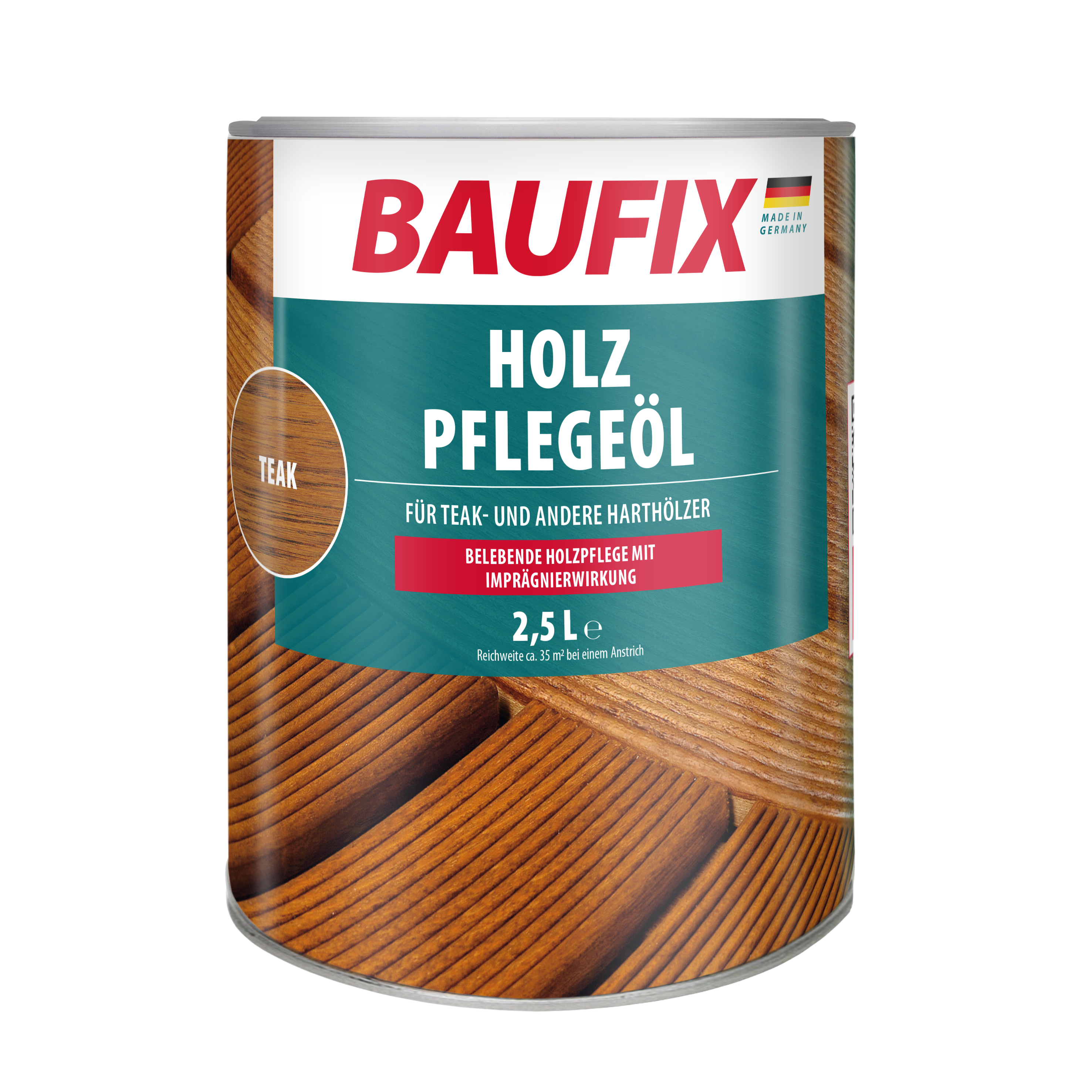
subheading
Our wood oil: BAUFIX Wood Care Oil
- enhances the natural wood color
- for wooden terraces & walkways
- for teak & hardwoods
- with waterproofing effect
- deep-acting, invigorating wood care
- for outside & inside

